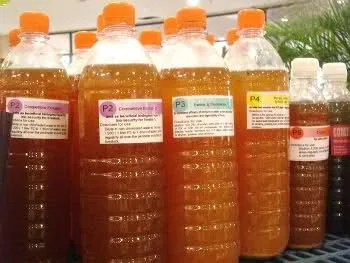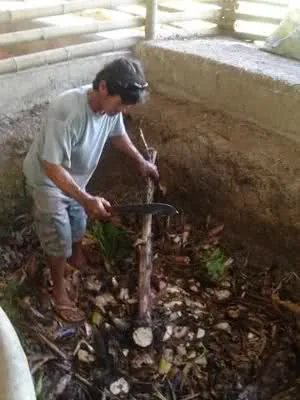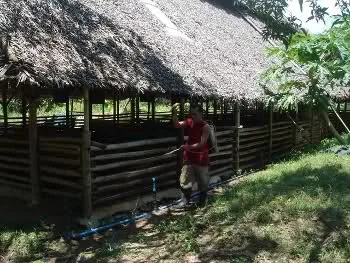The Peñalosa Farms, situated at the heart of Victorias City and expands to the town of Manapla, is a model for integrated natural farming business.
It is owned by Ramon “Mon” D. Peñalosa. Jr., an established farmer-entrepreneur in the province of Negros Occidental, who envisions an organic agricultural landscape using appropriate indigenous technology. Peñalosa’s technology seeks to promote and provide a natural farming system that is environment-friendly, sustainable and replicable.
As an integrated farmer-entrepreneur, Peñalosa produces rice, vegetables, fruits, poultry and livestock that are free of chemical fertilizer and pesticide. His passion for organic farming has driven him to research more and unselfishly share his technologies to those who are interested.
Peñalosa’s micro-agricultural farm is located at Barangay 5, Victorias City inside the family-owned machine shop compound. At the back of the compound is a low-lying swampy area of about 2,500 square meters which was initially in 2000 planted to kangkong. Shop workers harvested kangkong for their viands. As the harvest increased, Mon decided to raise swine with kangkong as their source of feed. Starting with six heads, the business has grown bigger with 208 heads this year. Since its small beginnings, the swine business has become the farm’s anchor project.
With a limited area in Victorias City, Mon expanded his swine business to another family-owned property in Hacienda Remedios in the town of Manapla. There, Mon devised a unique swine cultural management practice that includes a no-bath system and low-cost housing with flooring made from natural compost ingredients. From kangkong feeding, he introduced the use of probiotics in swine. Probiotics are dietary supplements of live microorganisms which, when administered in adequate amounts, greatly benefit the host.
Mon has formulated and used “job-specific” microbials to hasten decomposition, increase amino acid and lactic acid production, provide an odorless environment, and control fly production. He eventually established his own laboratory where these microbials are cultured and harvested to produce the probiotics which serves as one of the ingredients in his feed formulation. In his experience, the use of probiotics assures him of productivity because of an improved immune function of his animals, thus, preventing infection. Also, Peñalosa’s farm is environment-friendly because it is odor-free, antibiotic-free and highly recommended for public health safety.
RAISING PIGS THE PEÑALOSA WAY
Hog raising at Peñalosa Farms is called PROBIOTIC-BASED SWINE CULTURE. Ths is the result of Mon’s research on alternative medicine to protect the health of his pigs. It features formulations of beneficial organisms and enzymes as well as vitamins and minerals which are added to animal feeds. PROBIOTICS virtually suppress the growth of harmful bacteria, which then improves the immune system of the animals that enable them to combat stress and resist diseases.
An interesting feature of his probiotic-based swine culture is ‘La’ Ligo’ or the no-wash technology.
BREEDS AND BREEDING PRACTICES
COMMON BREEDS RAISED AT PEÑALOSA FARMS
1. Large white are proven to be a rugged and hardy breed that can withstand variation in climate and other environmental factors. Their ability to cross with and improve other breeds gives them a leading role in commercial pig production. Though they were developed as an active and outdoor breed, they do very well in intensive production systems. Descendants developed from crossbreeding and rotational breeding programs form the foundation of the classic F1 hybrid gilt. Pure-breed large white terminal sires excel in growth rate and have a high lean meat percentage.
2. Landrace are white, with droopy ears that slant forward with its top edges nearly parallel to the bridge of its straight nose. This breed is known for their body length, high percentage of carcass weight in the ham and loin areas, and ideal amount of finish. Aside from being prolific sows that farrow large litters, stocks of this breed are also heavy milkers.
3. Duroc breeds possess the characteristics of having large litters and the ability to grow quickly. They also have deep body, ham and shoulder, and have better carcass quality. The hair coat of this breed molts during summer leaving the pig looking bald and therefore can cope with hot temperature. This breed is characterized by its good mothering ability and docility. Its succulence and heavy muscling makes it very suitable for light pork to heavy hog production.
Other specific breeds as a result of crossbreeding by Mon are the following:
1. 337 – a cross between Large white and Duroc
2. 399 – a cross between Landrace and Large white
3. ACMC – a cross between Chinese Meisan and European Landrace
BREEDING PRACTICES
Only 1 percent is bred the natural way while 99 percent are inseminated artificially using farm boars. For genetic improvement, genes from the nucleus farm are used. The animals are allowed to fight to “stress them” so they could produce reproductive hormones needed for breeding.
FEEDS AND FEEDING
To ensure proper nutrition for the animals, Mon is equipped with basic feed milling equipment like the hammermill and feed mixer. Feed ingredients include corn, soya, whey powder, fish meal, and rice bran mixed with feed base mix. These ingredients vary as to availability, and the required Metabolizable Energy (ME) and Crude Protein (CP) for each stage of swine are followed in the formulation.
Basically, animals aged 6 to 54 days are fed with pre-starter formulation and gradual changes are being done using starter ration. Producing booster feeds is expensive, thus, it is impractical to formulate this kind of ration.
The farm is formulating at least six swine rations, namely: Pre-Starter, Starter, Grower, Finisher, Gestating, and Lactating rations. PROBIOTIC solutions are being incorporated into the rations which, to his experience, produce good results.
Below are the PROBIOTIC solutions produced with corresponding purposes.
PEÑALOSA PROBIOTIC SOLUTIONS WITH JOB-SPECIFIC BACTERIA
Note: The use of PROBIOTICS in feeds is job-specific and has positive effects in FCR & ADG
FEEDS PREPARATION USING PROBIOTICS

Photo credit: Vishia Mae Dominic J. Tolcidas -FITS OPA Negros Occidental
Of the six solutions formulated, only P3 and P4 are used for internal purposes. The rest are applied externally. P3 is used to increase amino acid production and is highly recommended for grower and finisher rations of both swine and ruminants. P4 which contains lactic acid-producing organisms is generally used for lactating, gestating, pre-starter rations of swine as well as poultry and ruminants. This improves Feed Conversion Ratio (FCR) and increases Average Daily Weight Gain (ADG).
Follow these steps in preparing feeds using probiotics.
1. Mix 1-2 kilograms (kg) of molasses in 200 liters of non-chlorinated water with 1 liter of P3 or P4. Set aside for 1 day.
2. From the above solution, get 5 liters and mix with 20 liters of water to make a total of 25 liters. Use this to ferment 50-100 kg of rice bran.
3. Put in feed mixer and mix for 5-10 minutes. Pack in a bag or sack.
4. Set aside for 3-7 days before use.
5. Use the fermented rice bran as 50% replacement of the total feed consumption of the animal or just add-on.
RECOMMENDED FEEDING PER HEAD PER DAY
Note: For ready-to-use available feeds, 160 ml of the P3 or P4 molasses solution is mixed with 16 liters of water and then mixed with commercial feeds. The farm is practicing the wet feeding technique. With this feeding formulation, it has been observed that pigs are calmer and healthier.
HOUSING AND MANURE MANAGEMENT FOR ’LA LIGO’ (NO-WASH) TECHNOLOGY
DESIGN AND CONSTRUCTION
The Roof
A monitor-type of roofing using semi-permanent and light materials like bamboo and nipa slabs with sun portals (vertical slide windows facing east and west) is built to let sunshine in the morning and afternoon to provide good ventilation and comfort to the animals. This also serves as disinfectant to the animals in the pen. The windows have plastic light savers. The trusses made of whole bamboos and reinforced by galvanized iron (GI) wires are built to withstand strong winds. The roof is angled at 45 degrees to facilitate easy rain spillage and prevent rapid deterioration of the nipa slabs during adverse weather conditions.
The Floor

Photo credit: Vishia Mae Dominic J. Tolcidas -FITS OPA Negros Occidental
A pit is dug with a dimension of 1 square meter per head of fattener and about 1 meter deep. This pit is filled with biodegradable indigenous materials like chopped banana trunks, milk ash, mud press, shredded rice straw, sugarcane tops, fruit and vegetable peelings, leaves and other weeds found in the farm. Since banana stalks are abundant in the area, they are used more often because they provide moisture necessary for rapid decomposition. The uppermost layer is covered with rice hull and each layer is sprayed with decomposing PROBIOTIC solution known as P1.
The floor serves as the loafing area and where the pigs can freely excrete their wastes. In cooler days, fatteners lie down or stay on rice hull-covered flooring for warmth brought about by the fermentation process. In hotter days, they stay on the cemented portion of the pen. Biodegradable indigenous materials are added every three weeks to prevent the pit from sagging, thus, protecting the animals.
The Wall Partition

Photo credit: Vishia Mae Dominic J. Tolcidas -FITS OPA Negros Occidental
Wall partition between pens is made of whole bamboo placed on top of the other over a concrete separator. At least five bamboos are piled one after the other. Whole bamboos reinforced with GI wires are recommended to strengthen all bamboo partitions instead of using common wire nails.
The Feeder and the Waterer
Feeders made of concrete with steel partition are located in the middle of the pen to provide access to all animals. Automatic drinkers are provided at the rear portion of the pen where the area is concrete and slanted at slight angle away from the pit to prevent water from seeping into the pit.
MANURE MANAGEMENT
After about five months or when they reach 85 to 90 kilograms liveweight, the fatteners are sold live to prospective buyers or brought to the slaughterhouse. Processing and value-adding are done in Bacolod City at the family’s backyard processing center as well as at the family-owned meat shop and restaurant.
After emptying the pen with the animals, the decomposed materials that served as flooring are collected and placed in a sack either to be used directly as fertilizer of plants within the farm, or stacked as materials for vermicasting. Vermicast becomes one of the ingredients in the production of bio-formulated vermi-reinforced organic fertilizer (BFVROF) or are sold directly to interested farmers. Each sack of decomposed materials sells at P150.00 per sack while BFVROF sells at P500.00 per bag.
PECULIARITIES IN CARE AND MANAGEMENT
FEED THEM WELL SO THEY WILL “GO TO HEAVEN” SOON.
The practice of feeding the fatteners with appropriate feed mixture mostly from locally-produced feed materials incorporated with PROBIOTICS assures healthier meat with less backfat. It will provide the farmer with a better, affordable market and easy income.
“STRESS THEM”.
When the breeders are stressed through fighting with one another, they release hormones that make them more prolific, thereby giving the farmer increased number of piglets during farrowing.
FOR REHEAT DETECTION
Allowing a boar to rove will make sows excited because the latter get attracted to the boar, thus, the possibility of a reheat or rebreeding cycle.
NO-WASH TECHNOLOGY
The practice of no-wash technology will enable the farmer to save on operation cost and labor. The occurrence of swine diseases particularly pneumonia observed in various commercial piggery farms cannot be detected in this practice. If they do occur, these diseases are well managed.
HERD HEALTH
The farm’s herd health management includes: iron injection at 3 days of age; deworming and hog cholera vaccination at one month old to be repeated every 6 months; and Vitamin B complex supplementation for males after castration.
For bio-security, P2 as co–infectant is used against any bacterial or fungal infection to overpower the growth of harmful organisms. P5 at a ratio of 160 ml in 16 liters of water is sprayed in pen houses, septic tanks and other areas that produce odor twice or thrice a week.
To control the production of flies and other insects, P6 is sprayed at a dilution of 160 ml in 16 liters of water every 15 days particularly in insect breeding areas or water-logged areas.
MARKETING
Pigs at Peñalosa Farms are sold live, slaughtered for choice cuts or for value adding and processing purposes. Slaughtering is done at Victorias Milling Company “AAA” slaughterhouse where the animals fast for 6-8 hours. They are weighed, bathed, stunned, hooked at the hoof with body hanged upside down, and killed with a pointed object at the neck. This is followed by dehairing, evisceration and backfat measurement. Blast freezing of the carcass is done at the family-owned meat shop in Bacolod City prior to cutting to desired choice cuts.
LIVE ANIMALS SOLD TO PROSPECTIVE BUYERS
1. Weanlings (first 8-10 kilos) = P2,000.00 and an additional of P100.00 per kilogram in excess of 10 kilos
2. Lechon = pigs weighing 20–49 kilograms
3. Finisher = 85–90 kilos at P90.00 per kilo liveweight
4. Culled breeder = Boar at P54.00 per kilo; Sows at P68.00 per kilo
5. Replacement gilts
6. Boars
RECORD-KEEPING
Records being maintained at the Probiotic Swine Farm of Mr. Peñalosa are the following:
1. Livestock Inventory
2. Daily Breeding, Farrowing and Weaning Records
3. Sow and Litter Performance Record
4. Boar Performance Record
5. Feed Consumption
6. Herd Health
7. Monthly and Yearly Performance Record
For more info contact:
Western Visayas Agriculture and Resources Research and Development Consortium
University of the Philippines Visayas
General Luna St., 5000 Iloilo City
Email: wesvarrdec@yahoo.com
Telefax: (033)335-0630
Production team
Prepared by
Vishia Mae Dominic J. Tolcidas
Information Service Specialist / RACG Representative
FITS OPA Negros Occidental
In collaboration with Ramon Dayrit Peñalosa, Jr.
Magsasaka Siyentista, FITS OPA Negros Occidental / WESVARRDEC
Photos
Vishia Mae Dominic J. Tolcidas
Layout and Design
Niño S. Manaog
RACG Staff, WESVARRDEC
Technical Consultant
Narissa M. Lemoncito, Dvm
Training Facilitator, TLDC-EEDD Negros Occidental
Editorial Consultants
Edna B. Garde
Public Information Officer/
Manager, Fits Opa Negros Occidental
Cora F. Navarra, Ph.D.
Racg Coordinator, Wesvarrdec
Joseph Edward O. Idemne
Consortium Director, Wesvarrdec
Funded by
Philippine Council for Agriculture, Forestry and Natural
Resources Research and Development
Department of Science and Technology
(PCARRD–DOST)
ALL RIGHTS RESERVED
March 2010
updated: 9/24/10
Do you like this Money Making Business Idea? content”> then please consider subscribing to our RSS feed. You can also subscribe by email and have new articles sent directly to your inbox. (Once you entered your e-mail address, you need to login to your e-mail account and click the link to confirm your subscription).


very informative.. tnx much.. am actually looking for a farm in luzon practicing the same system coz I would like to send my representative for actual and hands-on training if allowed… tnx
how can we eliminate mites fleas in rice hulls.
KAYPEEYES BIOTECH PRIVATE LIMITED Manufacturers of Probiotics and Feed Enzymes, Amylases, Amyloglucosidases, Cellulases, Pectinases, Xylanases, Proteases by harnessing the power of biotechnology through research and development, for improving the quality of life for all.
http://www.kpsbio.com/
Manufacturers of Probiotics and Feed Enzymes, Probiotic Strains, How to Choose Probiotics, Digestive Probiotics, Digestive Enzymes Probiotics, Probiotics and Nausea, Culturelle Research, Therabiotics
is p3/p4 also available in Manila and where can we get it?
what is p3 and p4? where is it sold in negros?
what is p3 and p4? where can we buy that in negros?
You can email them at wesvarrdec@yahoo.com or call them at (033)335-0630
Madali lang yan gawin ang P1 nila. IMO lang yan, FPJ, FFJ, LABS and etc.
I can teach you how to make it, pm me sa facebook